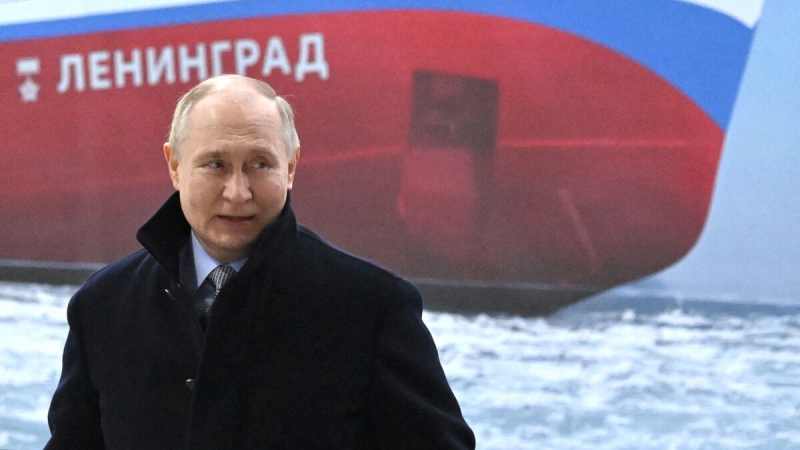
Putin Is Crushing the Arctic Ice While the US Is Barely Afloat
Russia is building up combat power in the polar region, and NATO needs a plan to counter him.
By Fletcher Dean Emeritus James Stavridis, former supreme allied commander of NATO
Ukraine was rightly the major focus at this week’s North Atlantic Treaty Organization summit in Washington. And as the meeting’s communiquéattests, the 75-year-old alliance has lots of other pressing challenges: in the Middle East, the Asia-Pacific, cyberspace and elsewhere.
Relatively little attention is paid, however, to a zone of geopolitical competition that could soon become a flashpoint for conflict: the Arctic. Russia is on the move up north, and to a lesser extent so is China. What should NATO consider as it looks at the polar region?
Russia is the largest coastal nation of the Arctic Ocean, taking up about half its shores. The other half is divided among the US, Canada, Denmark (Greenland is its dependent territory), Iceland and Norway. The recent addition of Sweden and Finland means NATO boasts seven of the eight countries holding real estate above the Arctic Circle.
The single non-NATO nation, of course, is the Russian Federation — and President Vladimir Putin has the most active and consistent Arctic program. Moscow is expanding and renewing its already formidable fleet of icebreakers: In the last four years, the Russians have put three new nuclear-powered ships into service, with at least another trio in the building yards.
But what has heads turning in NATO-world is the construction trial of a brand-new combat icebreaker, the very impressive Ivan Papanin. This Russian warship, which is diesel-electric rather than nuclear, is expected to be fully functional by the end of this year. Two more of the same class are coming right behind it.
Previous Russian icebreakers, like their NATO counterparts, have been essentially unarmed and designed for research, escorting merchant shipping and basic “presence operations” (showing the flag and demonstrating capabilities). But these new combat icebreakers have considerable offensive punch, including a 76mm high speed gun (similar to what serves on US frigates) and launchers for anti-ship and land-attack cruise missiles. These are serious warships weighing in at 9,000 tons, about the size of a US Arleigh Burke-class guided missile destroyer.
So the Russians will soon have a combat ship capable of crushing through the icepack in almost any winter conditions. The only vessels comparable in icebreaking performance are Norway’s Svalbard class, but they lack offensive combat capability.
The US Navy has no icebreakers. The Coast Guard’s antique Polar Star,commissioned in 1976, is on life support in a shipyard. The Coast Guard’s next-generation Polar Security Cutter program has been repeatedly delayed and gone hugely over budget, and isn’t expected to yield an operating craft until the end of the decade.
China, despite having no Arctic footprint, is nonetheless building icebreakers. Beijing has three midsize ships — the newest of which is the Ji Di class at nearly 6,000 tons — and a fourth on the way. While these are classified as research vessels, we know that Beijing is rarely without a military motive. In any case, the new ships are a clear signal that Putin and Chinese leader Xi Jinping are stepping up cooperation in NATO’s backyard.
Their joint plans may include threatening global supply chains that are opening up year-round in the melting icecap; conducting surveillance and presence missions throughout the Arctic Ocean; gaining valuable tactical experience, including coordination with subsurface operations by Chinese and Russian nuclear-powered attack submarines; and pushing Russian territorial claims for oil and gas exploration in contested zones.
What is NATO to do? A new Arctic strategy should rest on four pillars.
First, the alliance must take advantage of having added two new nations with significant Arctic experience. Sweden and Finland are members of the Arctic Council, a nongovernmental organization that focuses on all aspects of what the Canadians call the “High North.” Both have militaries with deep experience operating in severe cold. Quickly integrating Swedish and Finnish capabilities, and their political influence in the Arctic Council, is key.
Next comes creating the alliance’s combat icebreaking capability. The US must get the Polar Security Cutter program underway and consider refitting some of the Navy’s destroyers with “ice-hardened” hulls. The Canadians, whose defense spending is among the lowest in NATO, need to put resources toward Arctic maritime capability. At a minimum, they should ice-harden their new class of 15 planned surface combatants.
A third element is in surveillance, training and patrolling. While member nations conduct episodic operations, they must begin to think of the Arctic the way they do the Mediterranean or Baltic seas, where there are standing flotillas ready to conduct sustained combat. NATO should conduct exercises at least annually, hosted by Norway and Canada out of their northernmost bases. Satellite coverage of the region also needs improvement.
Finally, NATO needs to reshape its contingency plans and tabletop exercises. The alliance routinely develops and tests new strategies for protecting the Baltic states and Poland from Russia; it needs to do so for Arctic contingencies. I know from personal experience that it takes years for these defense plans to be developed, vetted and approved.
When I was NATO’s military commander a decade ago and raised my Arctic concerns with senior Canadians, they would tell me to relax, that it was “High North but low tension.” One joked that if the Russians attacked Canada across the Arctic, “We would end up performing search and rescue on them.” Maybe. But that was well before Putin’s invasion of Ukraine and his push on combat icebreakers. Russia’s Arctic capabilities are no longer a punch line.
(This post is republished from Bloomberg Opinion.)
